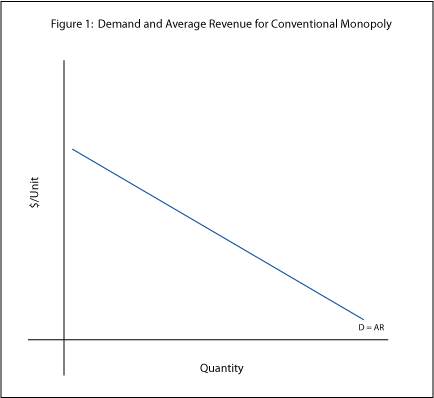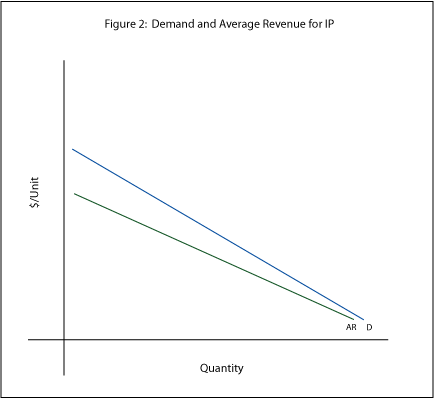
I question, though, whether that sort of graph does an adequate job of describing the sorts of monopolies protected by copyrights and patents. Because the law does not protect them perfectly, those sorts of "intellectual privilege" (the term I advocate in lieu of "intellectual property") suffer unremunerated uses. Some such uses happen through infringement, such as street corner sales of pirated DVDs. Others happen by dint of special legislative exceptions, such as the unlicensed public performances of musical works allowed to certain small commercial retail establishments.
Conventional monopolies, dealing in conventional goods, don't typically suffer a material gap between price and demand. The law does a pretty good job of preventing the theft and resale of electrical power, for instance. Physics makes that and most other goods fairly easy to protect from trespass. IP (which, recall, stands for "intellectual privilege") proves rather more difficult to bottle up, however. The law often fails to ensure that all the price—in time, effort, and sometimes cash—that consumers pay to use copyrights and patents ends up in the hands of IP owners. Figure 2, below, offers a picture of that phenomenon.

Even though it offers twice the lines of figure one, I grant that figure two remains rather sparse. Interesting things start to happen, though, when you use figure two as a foundation for more complicated pictures of the supply and demand for IP. You may note, too, that if figure 2 describes IP, it should likewise describe monopolies in other public goods—most notably, in the supply of government services. I'll hold off on exploring those ideas for now, though, as you readers may convince me to nip this particular experiment in the bud.
[NB: In the original version of figure two, the gap between AR and D held constant regardless of quantity. After some reflection, I edited it to instead show the two in constant proportion. That makes more sense as a matter of theory, since we would expect less recourse to unremunerated uses of a copyright work if it were licensed at a very cheap rate. Casual observation suggests the same result. Nobody, for instance, bothers trying to pirate the daily newspaper.]
[Crossposted to The Technology Liberation Front.]
2 comments:
I don't think this is quite right. Demand is defined as willingness and ability to pay. In the case of IP, people may be less willing to pay because of the possibilities for getting the benefits for free -- but that should be reflected in a lower demand, not a divergence between demand and average revenue. It will still be the case that, for any given price P, there will be some quantity Q units that will be purchased (rather than, say, copied illegally), and that is a point on the demand curve. The total revenue will be P*Q, and the average revenue per unit sold will be P*Q / Q = P.
I think what you're trying to say is that value received by customers will differ from demand -- specifically, it will be higher, since at any given price there will be some people who enjoy the good without having paid. For that reason, we cannot treat the demand curve as representing the marginal value of the last unit sold, and we cannot treat the area underneath it as the consumer surplus.
To represent this issue, I think you'll want to use your distinction (from prior posts) between express demand and implied/hypothetical demand, the latter of which represents how much people "really" benefit from the good (and would pay if there were no problems of free-riding and such).
Thanks, Glen, for those informed comments. Perhaps I've taken undue liberties with the meaning of "demand," as you economists use it. I'd imagined, though, that it would reflect not simply money changin hands but also opportunities foregone. Thus, for instance, if I am willing to walk across town to hear a free concert, I am in a very real sense paying for a copyrighted performance. But, of course, my costs do not equate to the copyright owner's gain.
And, anyhow, what if we set aside unremunerative consumption generally (such as fair uses or library borrowing) to focus specifically on the purchase of pirated copies? In those cases, we do have a fair price signal of consumer demand. But the prices paid do not in those cases go to the copyright owner.
Post a Comment